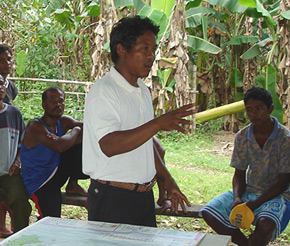
Coron Island est un archipel plein de récifs coralliens, lagunes saumâtres, mangroves, forêts de calcaire et de la biodiversité florissante. Il y a dix lacs de la région considérés comme sacrés par le Calamian Tagbanwa, appelé Panyu de. Les lacs sont également officiellement reconnus par l'État comme territoires ancestraux autochtones. Face aux pressions croissantes du développement telles que l’exploitation minière et la pêche moderne, il est douteux que cette reconnaissance réussisse à protéger les valeurs culturelles et biologiques des terres calamiennes Tagbanwa..
Le Calamian Tagbanwa est un poisson ing personnes dont les règles coutumières réglementent la pêche, y compris pour définir où la pêche est autorisée. D'autres zones ne peuvent être pénétrées à des fins culturelles que lorsque la permission des esprits est obtenue. Il est regrettable qu'un afflux de migrants et de jeunes qui ne respectent pas les règles coutumières menacent ces espaces sacrés.. Leurs méthodes de pêche plus modernes sont moins durables et les zones réglementées traditionnellement définies et les réglementations de pêche ne sont pas respectées.. Les Calamiens Tagbanwa croient que ces violations bouleversent les esprits et la pieuvre mythologique géante., Kunlalalala, qui vivent dans les lacs.
ing personnes dont les règles coutumières réglementent la pêche, y compris pour définir où la pêche est autorisée. D'autres zones ne peuvent être pénétrées à des fins culturelles que lorsque la permission des esprits est obtenue. Il est regrettable qu'un afflux de migrants et de jeunes qui ne respectent pas les règles coutumières menacent ces espaces sacrés.. Leurs méthodes de pêche plus modernes sont moins durables et les zones réglementées traditionnellement définies et les réglementations de pêche ne sont pas respectées.. Les Calamiens Tagbanwa croient que ces violations bouleversent les esprits et la pieuvre mythologique géante., Kunlalalala, qui vivent dans les lacs.
Heureusement, la plupart des jeunes respectent encore les enseignements des aînés.. Une solution pour assurer le maintien des zones sacrées est de former les anciens et les communautés à réagir aux menaces qui pèsent sur leurs terres.. L'un des aspects de cela est de permettre aux aînés et aux communautés d'organiser des réunions au cours desquelles leurs connaissances traditionnelles sont enseignées à la prochaine génération.. De cette manière, la jeune génération est continuellement impliquée dans les connaissances sacrées et le droit coutumier..
Pour plus d'informations, consultez la description du site sur le site ou lisez l'étude de cas préparée par Arlene Sampang pour le livre: Sites naturels sacrés, conserver la nature & culture, chapitre 24.
En: Rianne Doller






